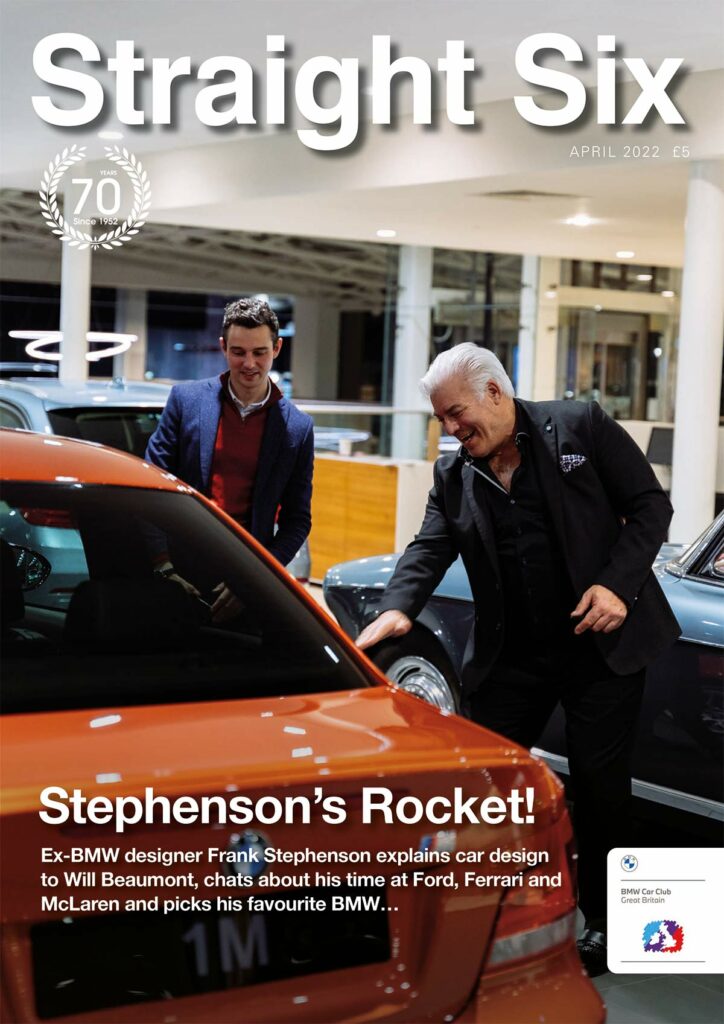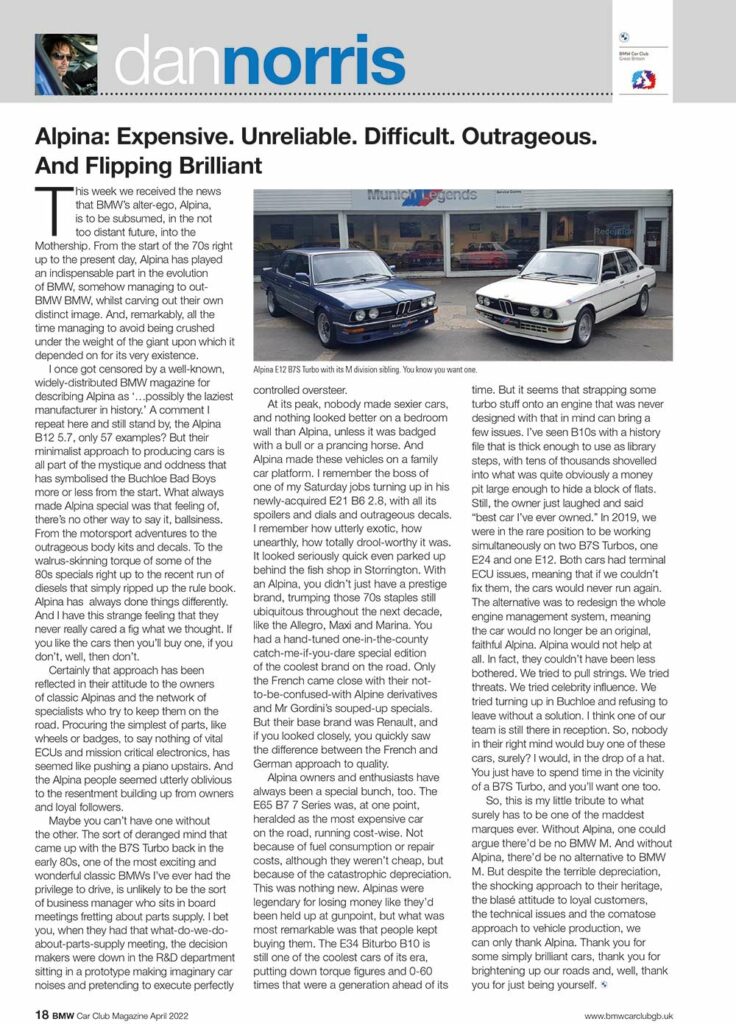Alpina: Expensive. Unreliable. Difficult. Outrageous. And Flipping Brilliant
So, this week we received the news that BMW’s alter-ego, Alpina, is to be subsumed in the not too distant future, into the Mothership. From the start of the 70s right up to the present day, Alpina have played an indispensable part in the evolution of BMW, somehow managing to out-BMW BMW, whilst carving out their own distinct image and all the time – remarkably – managing to avoid being crushed under the weight of the giant upon whom they depended for their very existence.
I once got censored by a well-known, widely distributed BMW magazine for describing Alpina as ‘…possibly the laziest manufacturer in history’ – a comment I repeat here and still stand by (Alpina B12 5.7 – 57 cars?). But their minimalist approach to producing cars is all part of the mystique and oddness that have symbolised the Bucheloe Bad Boys more or less from the start. What always made Alpina special was that feeling of – there’s no other way to say it – ballsiness. From the motorsport adventures to the outrageous body kits and decals, to the walrus-skinning torque of some of the 80s specials – right up to the recent run of diesels that simply ripped up the rule book, Alpina have always done things differently – and I have this strange feeling that they never really cared a fig what we thought. If you like the cars then you’ll buy one, if you don’t, well, then don’t.
Certainly that approach has been reflected in their attitude to the owners of classic Alpinas, and the network of specialists who try to keep them on the road. Procuring the simplest of parts – like wheels or badges, to say nothing of vital ECUs and mission critical electronics – has at times seemed like pushing a piano upstairs, with the Alpina people utterly oblivious to the resentment building up from owners and loyal followers.
Maybe you can’t have one without the other. The sort of deranged mind that came up with the B7s turbo back in the early 80s – one of the most exciting and wonderful classic BMWs I’ve ever had the privilege to drive – is unlikely to be the sort of business manager who sits in board meeting fretting about parts supply. I bet you when they had that ‘what do we do about parts supply’ meeting, the decision makers were down in the R&D department, sitting in a prototype making imaginary car noises and pretending to execute perfectly controlled oversteer.
At their peak, nobody made more sexy cars, and nothing looked better on a bedroom wall than Alpina, unless it was badged with a bull or a prancing horse. And Alpina made these vehicles on a family car platform. I remember the boss of one of my Saturday jobs turning up in his newly acquired E21 B6 2.8, with all its spoilers and dials and outrageous decals, and I remember how utterly exotic, how unearthly, how totally drool worthy it was. It looked seriously quick even parked up behind the fish shop in Storrington. With an Alpina, you didn’t just have a prestige brand, trumping those 70s staples – still ubiquitous throughout the next decade – like the Allegro, Maxi and Marina. You had a hand-tuned, one-in-the-county, catch-me-if-you-dare special edition of the coolest brand on the road. Only the French came close, with their not-to-be-confused-with Alpine derivatives, and Mr Gordini’s souped-up specials. But their base brand was Renault, and if you looked closely, you quickly saw the difference between the French and German approach to quality.
Alpina owners and enthusiasts have always been a special bunch, too. The E65 B7 7 series was at one point heralded as the most expensive car on the road, running cost-wise – not because of fuel consumption or repair costs (although they weren’t cheap) – but because of the catastrophic depreciation. This was nothing new – Alpinas were legendary for losing money like they’d been held up at gunpoint – but what was most remarkable was that people kept buying them. The E34 Biturbo B10 is still one of the coolest cars of its era, putting down torque figures and 0-60 times that were a generation ahead of their time. But it seems that strapping some turbo stuff onto an engine that was never designed with that in mind can bring a few issues. I’ve seen B10s with a history file that is thick enough to use as library steps, with tens of thousands shovelled into what was quite obviously a money pit large enough to hide a block of flats, and the owner just laughed and said ‘best car I’ve ever owned’. In 2019, we were in the rare position to be working simultaneously on two B7s turbos – one E24 and one E12. Both cars had terminal ECU issues, meaning that if we couldn’t fix them, the cars would never run again. The alternative was to redesign the whole engine management system, meaning the car would no longer be an original, faithful Alpina. Alpina would not help at all. In fact, they couldn’t have been less bothered. We tried to pull strings. We tried threats. We tried celebrity influence. We tried turning up in Bucheloe and refusing to leave without a solution. I think one of our team are still there in reception. So, nobody in their right mind would buy one of these cars, surely? I would, in the drop of a hat. You just have to spend time in the vicinity of a B7s turbo, and you’ll want one too.
So, this is my little tribute to what surely has to be one of the maddest marques ever. Without Alpina, one could argue there’d be no BMW M. And without Alpina, there’d be no alternative to BMW M. But despite the terrible depreciation, the shocking approach to their heritage, the blasé attitude to loyal customers, the technical issues and the comatose approach to vehicle production, we can only thank Alpina. Thank you for some simply brilliant cars, thank you for brightening up our roads and, well, thank you – just for being yourselves.
Dan Norris, Straight Six Magazine by BMW Car Club GB (April 2022 issue)


